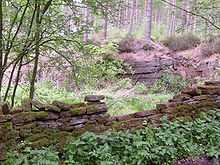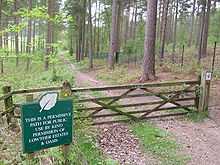Whinfell Forest
Whinfell Forest is now a small area of woodland in the parish of Brougham, Cumbria that lies south east of Penrith in Cumbria and just off the A66 road leading to Appleby-in-Westmorland. The forest is a short distance from the Lake District national park and is surrounded by a large number of woodlands that are located west of the Pennines. It is notable today for the presence of Center Parcs and a Red Squirrel reserve. It was notable historically for its associations with Lady Anne Clifford, Brougham Castle and Inglewood Forest.
History

Whinfell Park was at the core of the forest. Its proximity to Inglewood Forest meant that it was mentioned in court documents relating to disputes between the two areas. The park contained two frequently-mentioned landmark trees: the Harthhorn Tree and the Three Brother Tree.[3] The harthorn tree had a hart's horn embedded in it. The Three Brother Tree was the sole survivor of three unusually large oaks called the Three Brethren. The site of the Harthorn Tree is marked on old maps. The name "Three Oaks" is used within the Center Parcs site. By 1779, the park had been divided into farms by enclosure.[1][4]
Today, the forest forms part of the Lowther estates. A large part of it is designated by Natural England as Ancient Replanted Woodland.
Holiday village


In 1993 a leisure resort was planned for the site under the proposed name "Lakewoods Holiday Village".[5] The Rank Group constructed this as "Oasis Lakeland Holiday Village" which featured commercial restaurants and businesses such as Burger King and a Hard Rock Cafe. It was later sold to Center Parcs who removed the commercial ventures and now operate it as "Whinfell Forest Village".
Whinfell Forest is the largest of Center Parcs' four UK holiday villages, with accommodation for 4,668 people in 861 units.
See also
References
- ↑ 1.0 1.1 B. Tyson, "Oak for the Navy: a case study", Transactions CWAAS 85:117-126, 1985.
- ↑ H.R.T. Summerson et al., Brougham Castle, Cumbria, English Heritage, 1988.
- ↑ Thomas Cox, Magna Britannica et Hibernia, Volume 6: Westmorland, 1731.
- ↑ I. Whyte, Transforming Fell and Valley, Centre for North West Regional Studies, Lancaster, 2003.
- ↑ Cobham Research Consultants, Lakewoods Holiday Village Environmental Statement, Cobham Research Consultants, Abingdon, 1993.
| |||||||||||||||||
Coordinates: 54°38′23″N 2°39′34″W / 54.6397°N 2.6595°W